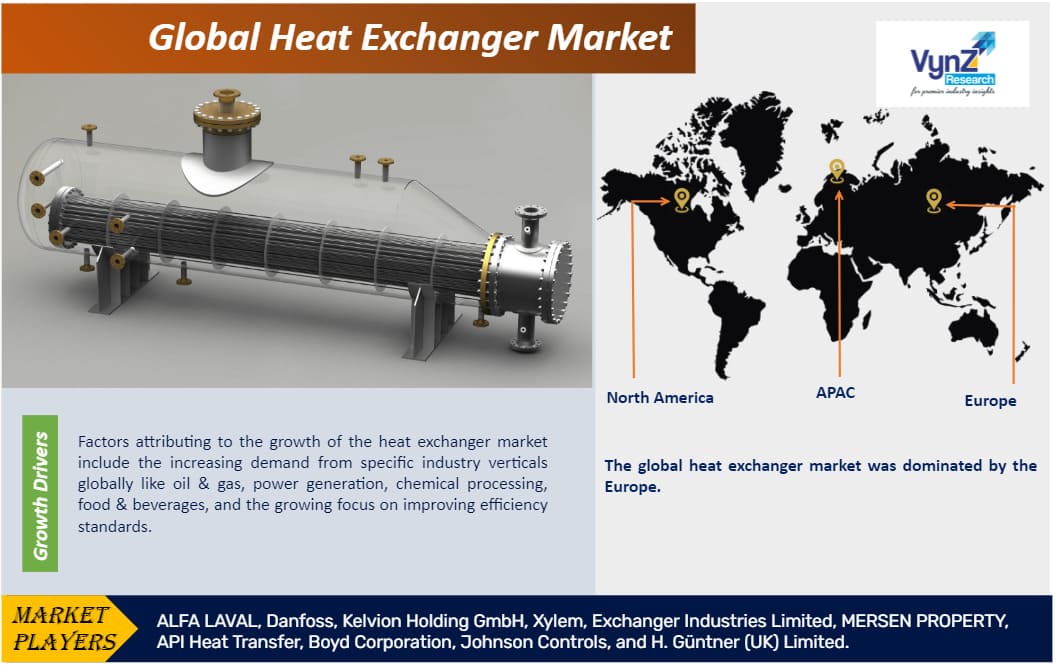| Status : Published | Published On : Dec, 2024 | Report Code : VRCH2078 | Industry : Chemicals & Materials | Available Format :

|
Page : 200 |

Global Heat Exchanger Market – Analysis and Forecast (2025-2030)
Industry Insight by Material (Steel and Non-Steel), by Type (Plate & Frame Heat Exchanger, Shell & Tube Heat Exchanger, Air-Cooled Heat Exchanger, and Others), by Industry Vertical (Chemical, Energy, HVACR, Food & Beverages, Power Generation, Pulp & Paper, and Others), and Geography (North America, Europe, Asia-Pacific, Middle East, and Rest of the World)
Industry Overview
The global heat exchangers market is expected to be worth USD 20.5 billion by 2030, expanding at a 5.25% CAGR during 2025-2030. The heat exchanger is equipment or device which transmits heat and saves energy. It's an energy transfer device that works with two or more process fluids. Heat exchangers are used in a variety of domestic and industrial applications, such as steam power plants, chemical processing facilities, building heat and air conditioning systems, and transportation power systems, etc. The rising prominence for heat exchangers in oil & gas industries to extract crude oil will fuel the demand for heat exchangers in the oil & gas industry. Shell & tube, plate & frame, and other types of heat exchangers are widely used in a variety of industries, including chemical, petrochemical, oil & gas, food & beverage, HVACR, power generation, and others.

Heat Exchanger Market Segmentation
Insight by Material
Based on material, the global heat exchanger market is bifurcated into steel and non-steel. Stainless steel is widely used because of its advantageous qualities, which include corrosion resistance across a wide pH range, lightweight, high thermal conductivity, and does not require special fluids because it is compatible with plain clean water. It is a little expensive, but because of the aforementioned features, it is recommended for long-term use.
Insight by Type
Based on type, the global heat exchanger market is categorized into plate & frame heat exchanger, shell & tube heat exchanger, air-cooled heat exchanger, and others. The plate & frame heat exchanger is sub-divided into the brazed plate & frame heat exchanger, gasketed plate & frame heat exchanger, welded plate & frame heat exchanger, and others. The shell & tube heat exchanger segment is anticipated to contribute to the largest share of the heat exchanger market owing to the convenience offered to operate at high temperatures and pressures and easy servicing. Thus, the rising demand for shell & tube heat exchangers for several applications in industry verticals such as power generation, chemicals, and oil & gas will propel the growth of the market.
Air-cooled heat exchangers are anticipated to have a high CAGR as they are mainly used across refineries, gas processing plants, power plants, and petrochemical plants to transfer heat effectively and utilize waste heat.
Insight by Industry vertical
The global heat exchanger market is classified on the basis of industry verticals into chemical, energy, HVACR, food & beverages, power generation, pulp & paper, and others. The chemical industry dominates the heat exchanger market. Heat exchangers are becoming more prominent in the chemical industry due to their use in a variety of complex processes such as heating, cooling, condensing, evaporation, separation, and others. Furthermore, heat exchangers can resist continuous chemical interactions, enabling the safe and efficient completion of crucial processes. HVACR is anticipated to be the fastest-growing segment owing to the rising demand for AC and refrigeration units, especially in the Asia-Pacific region. The energy segment is expected to have a high CAGR during the forecast period owing to the rising demand in the downstream and upstream processing industry globally.
Global Heat Exchanger Market Report Coverage
|
Report Metric |
Details |
|
Historical Period |
2018 - 2023 |
|
Base Year Considered |
2024 |
|
Forecast Period |
2025 - 2030 |
|
Market Size in 2024 |
U.S.D. xx Billion |
|
Revenue Forecast in 2030 |
U.S.D. 20.5 Billion |
|
Growth Rate |
5.25% |
|
Segments Covered in the Report |
By Material, By Type, and By Industry Vertical |
|
Report Scope |
Market Trends, Drivers, and Restraints; Revenue Estimation and Forecast; Segmentation Analysis; Impact of COVID-19; Companies’ Strategic Developments; Market Share Analysis of Key Players; Company Profiling |
|
Regions Covered in the Report |
North America, Europe, Asia-Pacific, Middle East, and Rest of the World |
Industry Dynamics
Industry Trends
The inception of Industry 4.0 has led to capacity expansion activities globally, rising adoption of heat exchangers in the heat recovery process, and its use in fluid applications, improved technical needs in process industries, and mounting urbanization and industrialization in emerging economies are the key trends in the global heat exchanger market.
Heat Exchanger Market Growth Drivers
Factors attributing to the growth of the heat exchanger market include the increasing demand from specific industry verticals globally like oil & gas, power generation, chemical processing, food & beverages, and the growing focus on improving efficiency standards. Some of the other growth drivers for the growth of the heat exchangers market include a surge in HVACR deployment and other industrial activities, mounting energy prices, and robust industrial development in emerging markets like Asia-Pacific. Furthermore, the market is anticipated to grow considerably owing to the increasing installation of power plants globally, rising demand for sustainable energy development to effectively utilize waste heat generated from several industries, rapidly growing construction activities in residential and commercial sectors, favorable government initiatives, technological innovations will bolster the growth of the market. Nevertheless, Continuous technological innovations in heat exchanger development, such as rapid 3D prototyping, phase-change cooling technology, and research and development efforts, are stimulating market demand for heat exchangers during the forecast period.
Heat Exchanger Market Challenges
Less awareness about buildings’ energy efficiency, fluctuation in raw material prices, and a slowdown in demand for heat exchangers from Europe and North America may hamper the growth of the heat exchangers market. Because of the complicated designs of heat exchangers, such as tubular heat exchangers, cleaning and maintenance become more challenging when scaling and corrosion problems emerge. This aspect is expected to stifle the market for heat exchangers.
Heat Exchanger Market Opportunities
The rapid urbanization and industrialization in developing economies like China and India that need more power generation will create opportunities for industry players in the heat exchanger market. The rising usage of heat exchangers in nuclear reactors, as well as the upgrade of existing nuclear plants and proposed new nuclear power plant projects, are major possibilities for the heat exchangers market players.
Recent Developments By the Key Players
Alfa Laval has acquired NRG Marine, a provider of ultrasonic anti-fouling solutions for marine, oil and gas, and industrial applications, headquartered in the United Kingdom. This acquisition aligns with Alfa Laval’s strategy to provide its customers with environmentally friendly solutions, contributing towards improving operational efficiency, reducing costs, and extending lifecycle of the asset.
Heat Exchanger Market Geographic Overview
Europe accounts for the largest share of the global heat exchanger market due to the presence of well-established manufacturing, automotive, and industrial sectors. Moreover, setting up zero-emission regulation standards for commercial and residential infrastructure, emphasis on less carbon-intensive processes, and mounting demand for sustainable energy consumption will accelerate the growth of the heat exchanger market in the region.
Due to expanding industrial growth in countries like China, India, Japan, and South Korea, Asia-Pacific is expected to be the fastest-growing region in the heat exchanger market. The demand for heat exchangers is growing due to the surge in demand from the chemical, HVACR, petrochemical, and oil & gas industries, as well as government initiatives in countries like Japan and India to produce thermal and solar energy. Furthermore, the market for heat exchangers is likely to benefit from the growing demand for petrochemical products.
Heat Exchanger Market Competitive Insight
The industry players are emphasizing technological innovations, product development, strategic partnerships, M&A, and overseas business expansion to sustain themselves in the market. Furthermore, businesses are investing in R&D activities to increase heat transfer efficiency, launch cost-effective and efficient product variants, and have a competitive edge over other players. Also, e-commerce is acting as a driving force to enhance the sales of heat exchangers and manufacturers are focusing on efficient and effective distribution channels.
Some of the players in the global heat exchanger market include ALFA LAVAL, Danfoss, Kelvion Holding GmbH, Xylem, Exchanger Industries Limited, MERSEN PROPERTY, API Heat Transfer, Boyd Corporation, Johnson Controls, and H. Güntner (UK) Limited.
.png)
Region Covered in the Report
• North America
- U.S.
- Canada
- Mexico
• Europe
- Germany
- U.K.
- France
- Italy
- Spain
- Russia
- Rest of Europe
• Asia-Pacific (APAC)
- China
- Japan
- India
- South Korea
- Rest of Asia-Pacific
• Rest of the World (RoW)
- Brazil
- Saudi Arabia
- South Africa
- U.A.E.
- Other Countries
Frequently Asked Questions
Purchase Options
Latest Report
Research Methodology
- Desk Research / Pilot Interviews
- Build Market Size Model
- Research and Analysis
- Final Deliverabvle
Connect With Our Sales Team
- Toll-Free: 1 888 253 3960
- Phone: +91 9960 288 381
- Email: enquiry@vynzresearch.com
Heat Exchanger Market
